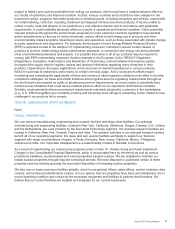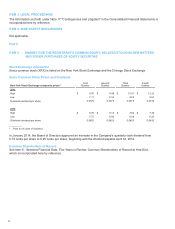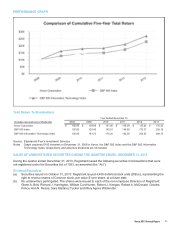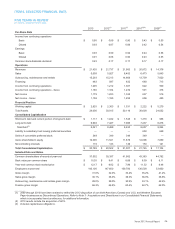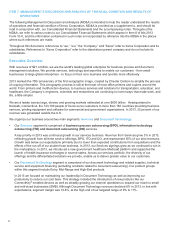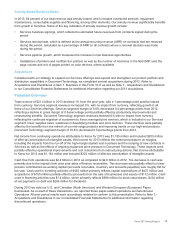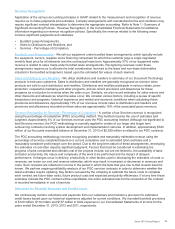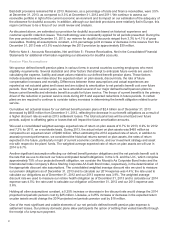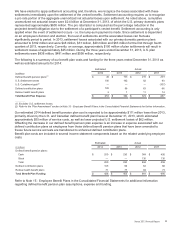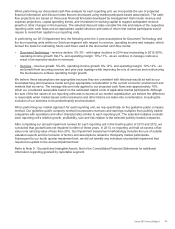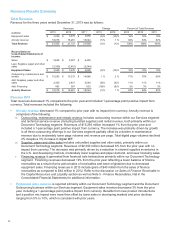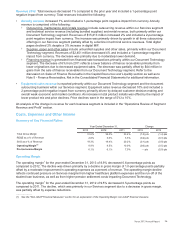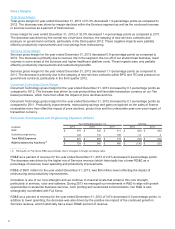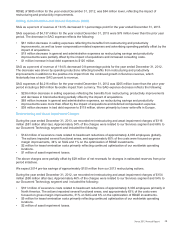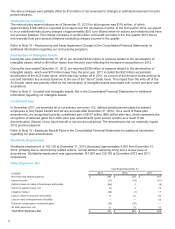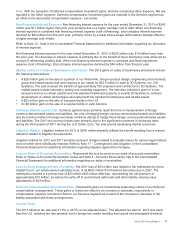Xerox 2013 Annual Report Download - page 48
Download and view the complete annual report
Please find page 48 of the 2013 Xerox annual report below. You can navigate through the pages in the report by either clicking on the pages listed below, or by using the keyword search tool below to find specific information within the annual report.Bad debt provisions remained flat in 2013. Reserves, as a percentage of trade and finance receivables, were 3.5%
at December 31, 2013, as compared to 3.3% at December 31, 2012 and 2011. We continue to assess our
receivable portfolio in light of the current economic environment and its impact on our estimation of the adequacy of
the allowance for doubtful accounts. In addition, although our bad debt provisions were relatively flat in Europe, this
region continues to be a focus of our credit review and analysis.
As discussed above, we estimated our provision for doubtful accounts based on historical experience and
customer-specific collection issues. This methodology was consistently applied for all periods presented. During the
five year period ended December 31, 2013, our reserve for doubtful accounts ranged from 3.3% to 4.1% of gross
receivables. Holding all assumptions constant, a 0.5-percentage point increase or decrease in the reserve from the
December 31, 2013 rate of 3.5% would change the 2013 provision by approximately $39 million.
Refer to Note 4 - Accounts Receivables, Net and Note 5 - Finance Receivables, Net in the Consolidated Financial
Statements for additional information regarding our allowance for doubtful accounts.
Pension Plan Assumptions
We sponsor defined benefit pension plans in various forms in several countries covering employees who meet
eligibility requirements. Several statistical and other factors that attempt to anticipate future events are used in
calculating the expense, liability and asset values related to our defined benefit pension plans. These factors
include assumptions we make about the expected return on plan assets, discount rate, the rate of future
compensation increases and mortality. Differences between these assumptions and actual experiences are
reported as net actuarial gains and losses and are subject to amortization to net periodic benefit cost over future
periods. Over the past several years, we have amended several of our major defined benefit pension plans to
freeze current benefits and eliminate benefit accruals for future service. The freeze of current benefits is the primary
driver of the reduction in pension service costs during 2013 and expected reductions in future periods. In certain
plans we are required to continue to consider salary increases in determining the benefit obligation related to prior
service.
Cumulative net actuarial losses for our defined benefit pension plans of $2.4 billion as of December 31, 2013
decreased by $855 million from December 31, 2012, reflecting the decrease in our benefit obligations as a result of
a higher discount rate as well as 2013 settlement losses. The total actuarial loss will be amortized over future
periods, subject to offsetting gains or losses that will impact the future amortization amounts.
We used a consolidated weighted average expected rate of return on plan assets of 6.7% for 2013, 6.9% for 2012
and 7.2% for 2011, on a worldwide basis. During 2013, the actual return on plan assets was $465 million as
compared to an expected return of $496 million. When estimating the 2014 expected rate of return, in addition to
assessing recent performance, we considered the historical returns earned on plan assets, the rates of return
expected in the future, particularly in light of current economic conditions, and our investment strategy and asset
mix with respect to the plans' funds. The weighted average expected rate of return on plan assets we will use in
2014 is 6.7%.
Another significant assumption affecting our defined benefit pension obligations and the net periodic benefit cost is
the rate that we use to discount our future anticipated benefit obligations. In the U.S. and the U.K., which comprise
approximately 75% of our projected benefit obligation, we consider the Moody's Aa Corporate Bond Index and the
International Index Company's iBoxx Sterling Corporate AA Cash Bond Index, respectively, in the determination of
the appropriate discount rate assumptions. The consolidated weighted average discount rate we used to measure
our pension obligations as of December 31, 2013 and to calculate our 2014 expense was 4.4%; the rate used to
calculate our obligations as of December 31, 2012 and our 2013 expense was 3.9%. The weighted average
discount rate we used to measure our retiree health obligation as of December 31, 2013 and to calculate our 2014
expense was 4.5%; the rate used to calculate our obligation at December 31, 2012 and our 2013 expense was
3.6%.
Holding all other assumptions constant, a 0.25% increase or decrease in the discount rate would change the 2014
projected net periodic pension cost by $25 million. Likewise, a 0.25% increase or decrease in the expected return
on plan assets would change the 2014 projected net periodic pension cost by $18 million.
One of the most significant and volatile elements of our net periodic defined benefit pension plan expense is
settlement losses. Our primary domestic plans allow participants the option of settling their vested benefits through
the receipt of a lump-sum payment.
31



